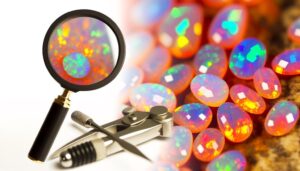5 Stunning Types of Fire Opal You Need to Know
You'll find fire opals exhibit diverse varieties, each with distinct features. Mexican Fire Opal, formed from volcanic activity, showcases vibrant play-of-color.
Jelly Fire Opal offers a translucent look with gentle flashes due to its silica matrix. Cantera Fire Opal, often embedded in rhyolite, presents a challenge to gem cutters.
Hydrophane Fire Opal absorbs water, altering its transparency and color. Ethiopian Fire Opal boasts vivid hues from volcanic origins.
Girasol Fire Opal enchants with a bluish glow and adularescence, while Cherry Fire Opal captivates with its iron oxide-induced red hues. For a deeper exploration, continue examining each variety's specifics.

Key Takeaways
- Mexican Fire Opal: Known for its vibrant hues and distinctive play-of-color due to light diffraction within its microstructure.
- Jelly Fire Opal: Exhibits a translucent appearance with subtle opalescence and gentle flashes of color.
- Cantera Fire Opal: Set within rhyolitic host rock, showcasing varied colors from oranges to reds.
- Ethiopian Fire Opal: Features unique color variations and high porosity, often absorbing liquids.
- Rainbow Fire Opal: Displays a mesmerizing spectrum of colors influenced by the diffraction of light within silica spheres.
Mexican Fire Opal

Mexican fire opal, known scientifically as hydrated silica, showcases a distinctive play-of-color due to its high water content and volcanic origin. You'll notice its vibrant hues range from yellow to red, attributed to the diffraction of light within its microstructure.
This diffraction occurs because of the ordered arrangement of silica spheres. When you examine these opals under different lighting conditions, their iridescence becomes more pronounced, revealing a spectrum of colors.
The volcanic activity in regions like Querétaro, Mexico, provides the necessary conditions for their formation, involving rapid cooling of water-rich lava. With a Mohs hardness of 5.5 to 6.5, Mexican fire opals require careful handling.
Their unique formation process makes them a compelling subject for both gemologists and collectors.
Jelly Fire Opal
In contrast to the vibrant hues of Mexican fire opal, Jelly fire opal exhibits a more translucent appearance, often showcasing a subtle play-of-color that can range from clear to milky white.
You'll notice that its internal structure allows light to diffuse, producing an ethereal glow. This opal type commonly displays opalescence, characterized by gentle, rolling flashes of color rather than intense bursts.
Its silica gel matrix, lacking significant impurities, contributes to its clarity. When appraising Jelly fire opal, consider its uniformity and the fluidity of its color play.
These features make it distinct from other fire opals, offering a unique aesthetic. Utilize proper lighting to observe its full spectrum of color and translucency for accurate evaluation.
Cantera Fire Opal
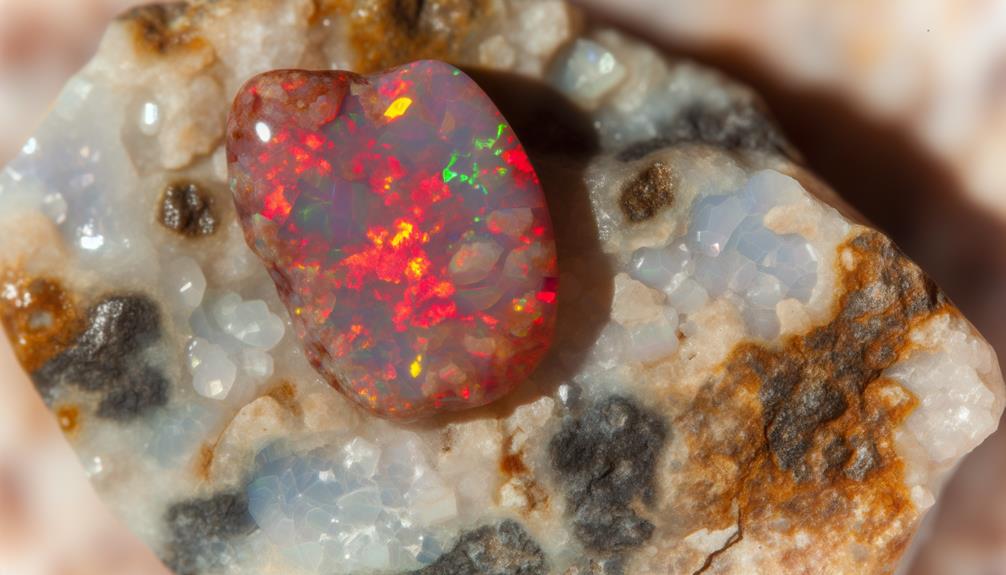
Cantera fire opal, often set within its rhyolitic host rock, presents a unique challenge for gem cutters due to its complex matrix and varied color distribution.
When working with this opal, you must carefully navigate the delicate interplay between the opal and its surrounding matrix. The rhyolitic host can vary widely in hardness, which complicates the cutting and polishing processes.
Cantera fire opals showcase a spectrum of colors, from vivid oranges to deep reds, often with flashes of green and blue. Precision is crucial to highlight these colors while maintaining the stone's structural integrity.
Ensuring proper orientation and minimal material loss during cutting enhances the stone's visual appeal, making your expertise critical in transforming rough cantera opal into a stunning gem.
Hydrophane Fire Opal
You're likely to find Hydrophane Fire Opal captivating due to its unique water absorption properties, which greatly influence its appearance.
This type of opal can display dramatic color play variations when exposed to water, making it a dynamic choice for collectors.
However, understanding its handling and care is essential since its porosity makes it more vulnerable to damage.
Water Absorption Properties
Hydrophane fire opal, known for its unique water absorption properties, can exhibit significant changes in transparency and color when exposed to varying humidity levels or direct immersion in water. When the opal absorbs water, its porous structure allows water molecules to fill gaps within the stone, increasing transparency and potentially altering its color intensity.
You might notice a hydrophane fire opal becoming more translucent or even transparent as it hydrates. Conversely, as the opal dehydrates, it reverts to its original opacity and coloration. This hydrophilic behavior is vital in the handling and storage of hydrophane opals, as excessive moisture can lead to structural stress and potential fracturing over time. Proper care ensures durability and aesthetic appeal.
Color Play Variations
Showcasing a mesmerizing interplay of colors, hydrophane fire opals exhibit dramatic shifts in their color play due to their unique water absorption properties.
When you immerse these opals in water, their porosity allows them to absorb moisture, which alters the light refraction within the stone. This change can intensify or modify the opal's spectral colors, creating a dynamic visual effect.
The term 'hydrophane' specifically refers to this water-responsive attribute. You'll notice that once they dry, the opals revert to their original color play. This fascinating phenomenon is a result of the internal microstructure of silica spheres, which rearrange as water content varies.
Understanding these variations helps you appreciate the exceptional qualities that distinguish hydrophane fire opals from other opals.
Handling and Care
Proper handling and care are essential to maintaining the unique visual properties and structural integrity of hydrophane fire opals. These opals are highly porous, absorbing water and other liquids. To prevent damage, avoid exposing them to water, chemicals, or extreme temperature fluctuations.
When cleaning, use a soft, dry cloth; never use ultrasonic cleaners or steam. Store hydrophane fire opals in a dry environment, ideally in a padded container to minimize physical stress. If your opal becomes wet, allow it to dry naturally at room temperature. Sudden drying can lead to cracking.
Additionally, avoid prolonged exposure to direct sunlight, as UV radiation can cause discoloration. By following these guidelines, you'll preserve the opal's beauty and integrity.
Ethiopian Fire Opal
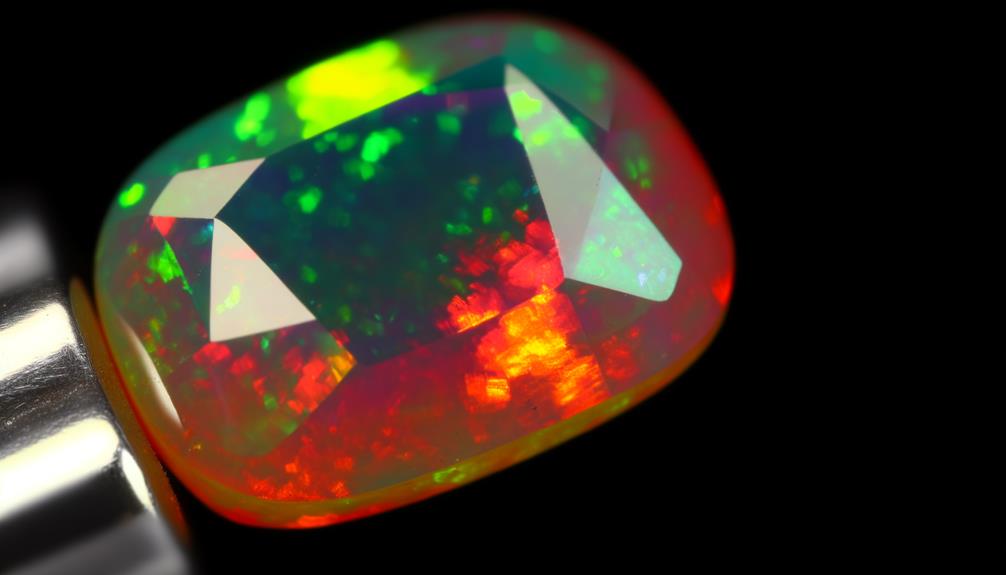
When examining Ethiopian Fire Opal, you'll notice unique color variations ranging from vibrant reds to soft yellows.
The geological formation process involves volcanic activity, resulting in a distinct hydrophane characteristic.
Proper care and maintenance are essential, as these opals are highly porous and can absorb liquids, impacting their color and clarity.
Unique Color Variations
Ethiopian fire opals frequently exhibit a diverse spectrum of unique color variations, ranging from vivid reds and oranges to mesmerizing blues and greens, due to their distinct mineral composition and trace elements. These opals are highly prized for their intense play-of-color, a phenomenon where the gemstone displays a shifting kaleidoscope of colors.
The unique hues are influenced by:
- Iron Oxide Content: Higher concentrations result in deeper red and orange shades.
- Hydration Levels: Variations in water content can cause opals to display a range of colors, including blue and green.
- Silica Structure: The arrangement and size of silica spheres determine the diffraction of light, contributing to the opal's vibrant play-of-color.
Understanding these factors enhances your appreciation of Ethiopian fire opals' unparalleled beauty.
Geological Formation Process
To fully appreciate the stunning color variations of Ethiopian fire opals, it's imperative to understand the geological formation process that imbues these gemstones with their unique characteristics.
Ethiopian fire opals form in volcanic environments, specifically within rhyolitic deposits. The silica-rich volcanic ash interacts with water over millennia, leading to the hydrothermal formation of opals.
This process occurs at relatively low temperatures, allowing microscopic silica spheres to arrange in a hydrated matrix. These silica spheres diffract light, resulting in the opal's play-of-color.
The presence of iron oxides and other trace elements further contributes to the diverse hues seen in Ethiopian fire opals. Understanding this intricate formation process highlights the natural artistry behind each gemstone's brilliance.
Care and Maintenance
Proper care and maintenance of fire opals, particularly those from Ethiopia, are essential for preserving their exquisite play-of-color and structural integrity. Ethiopian fire opals are hydrophane, meaning they can absorb water and become more fragile when wet.
To guarantee longevity, follow these guidelines:
- Avoid Water Exposure: Keep your opal dry to prevent absorption, which can lead to cracking or loss of color.
- Gentle Cleaning: Use a soft, dry cloth for cleaning. Avoid ultrasonic cleaners and harsh chemicals that could harm the stone.
- Proper Storage: Store your opal in a padded, dry container to safeguard it from physical impact and environmental moisture.
Brazilian Fire Opal
Renowned for its vibrant play-of-color and transparency, Brazilian Fire Opal is a highly sought-after variety in the gemological community.
You'll notice that this opal displays a captivating range of hues, from fiery reds and oranges to subtle yellows. Its transparency varies, often appearing as see-through or semi-translucent, enhancing its visual appeal.
The silica structure of Brazilian Fire Opal ensures optimal diffraction of light, resulting in its characteristic play-of-color. When assessing Brazilian Fire Opal, consider the clarity, color intensity, and overall brilliance. These factors greatly impact its value.
Unlike some other opals, Brazilian Fire Opal tends to have fewer inclusions, adding to its desirability among collectors and jewelers. Understanding these aspects will enhance your appreciation and knowledge of this exquisite gem.
Australian Fire Opal
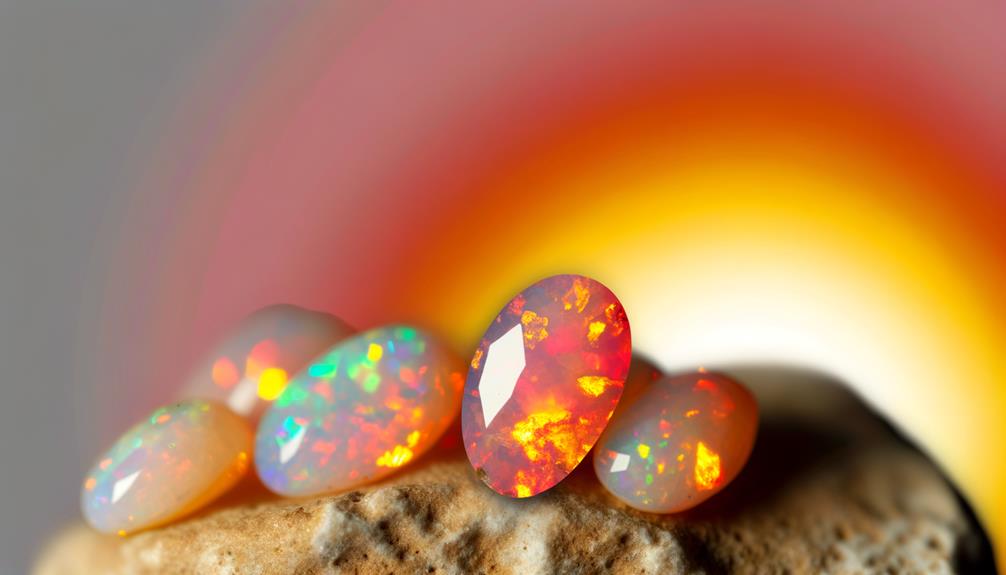
When examining Australian Fire Opal, you should focus on its origin and mining locations, which primarily include Lightning Ridge and Coober Pedy.
You'll notice its unique color spectrum, characterized by vibrant reds and oranges, often with a play-of-color effect.
Additionally, assess market value factors such as clarity, carat weight, and the rarity of its color patterns.
Origin and Mining Locations
Australia hosts some of the world's most significant deposits of fire opal, particularly in the renowned mining regions of Lightning Ridge and Mintabie. These locations are notable for their high-quality opals, which are mined under strict conditions to maintain structural integrity and maximize yield.
When examining Australian fire opals, consider:
- Geological Formation: Fire opals in these regions form in volcanic rock layers known as rhyolite, which creates the unique conditions needed for opalization.
- Extraction Techniques: Miners employ both open-cut and underground mining methods, depending on the depth and distribution of the opal seams.
- Resource Management: Sustainable practices are vital, focusing on minimizing environmental impact and ensuring the longevity of opal mining operations.
Understanding these elements helps you appreciate the complexity and value of Australian fire opals.
Unique Color Spectrum
The unique color spectrum of Australian fire opal, ranging from vivid reds and oranges to brilliant yellows, results from the diffraction of light through the microscopic silica spheres that compose the opal structure. These silica spheres, varying in size and arrangement, create an optical phenomenon known as play-of-color, leading to the gemstone's characteristic iridescence.
When light enters the opal, it bends and refracts within the tightly packed spheres. This interaction splits the light into its component colors, producing a spectrum that shifts with the angle of observation. The specific color range in Australian fire opal is influenced by the size of the spheres; smaller spheres yield blue and green tones, while larger ones produce the fiery reds and oranges.
Market Value Factors
Determining the market value of Australian fire opal relies on several crucial factors, including color richness, transparency, and carat weight.
When considering these opals, you'll want to keep in mind:
- Color Richness: The more intense and vivid the play-of-color, the greater the value. Look for a wide range of colors, with red and orange tones being especially prized.
- Transparency: Choose opals with minimal inclusions or fractures. Clearer opals reflect light more efficiently, enhancing their visual appeal and market worth.
- Carat Weight: Larger stones are more uncommon and therefore demand higher prices. However, balance size with quality, as smaller, high-quality stones can be more valuable than larger, flawed ones.
Each factor interacts to determine the overall value of these alluring gems.
Girasol Fire Opal
Girasol fire opal is characterized by its translucent to semi-translucent appearance and a unique bluish glow under light, standing out among various types of fire opal due to its distinct optical phenomenon.
You'll notice that this specific opal exhibits adularescence, a milky sheen or glow often mistaken for play-of-color. The bluish tinge, caused by scattered light, enhances its allure. When you examine it, the internal structure refracts light differently, creating a captivating glow.
Typically sourced from Mexico, known for high-quality specimens, girasol fire opals require proper handling to avoid surface scratches or fractures.
If you appreciate subtlety and sophistication in gemstones, the girasol fire opal offers a mesmerizing visual experience.
Cherry Fire Opal
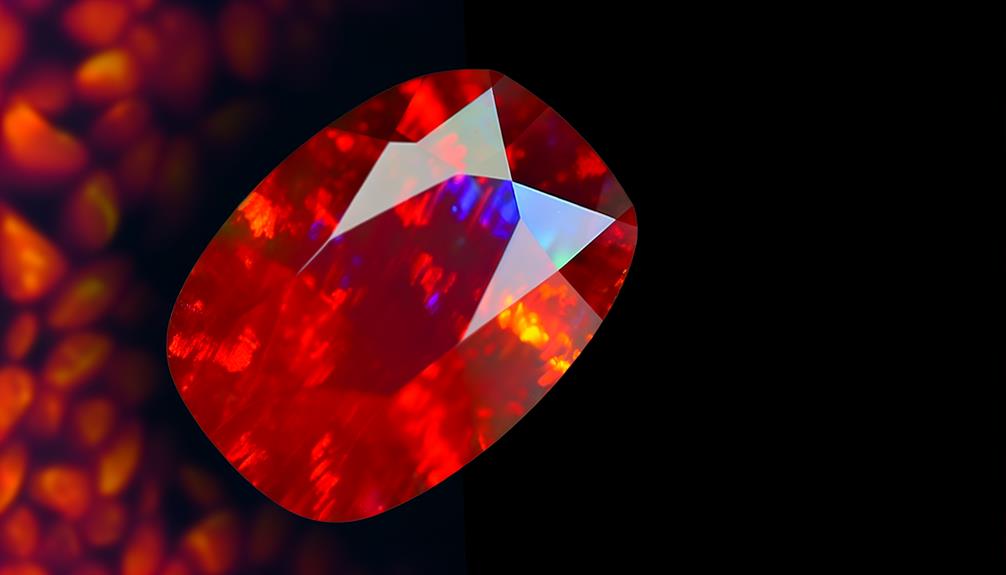
While the girasol fire opal enchants with its bluish glow, cherry fire opal captivates with its vibrant red to orange hues, reminiscent of ripe cherries, making it a standout among fire opals.
You'll find that its color results from trace amounts of iron oxide. Cherry fire opal is mainly found in Mexico, where it's highly valued for its vivid coloration and transparency.
When appraising a cherry fire opal, consider:
- Hue Consistency: Look for uniformity in color, avoiding stones with noticeable patches or gradients.
- Clarity: Higher transparency increases value, though minor inclusions are acceptable.
- Cut Quality: A well-executed cut enhances the stone's natural brilliance and color saturation.
Rainbow Fire Opal
Rainbow fire opal showcases a mesmerizing play of colors, often displaying flashes of green, blue, red, and yellow due to its unique internal structure.
You'll find that the diffraction of light within the silica spheres creates this vivid spectrum.
The size and arrangement of these silica spheres influence the specific colors seen. Smaller spheres generate blue hues, while larger ones produce reds and oranges.
Rainbow fire opals typically exhibit a higher degree of transparency compared to other opals, enhancing their brilliance.
When evaluating these gemstones, consider both the intensity and uniformity of their play-of-color. Their value increases with more vibrant and evenly distributed colors.
Proper care and handling are essential to maintain their stunning optical properties.
Common Fire Opal
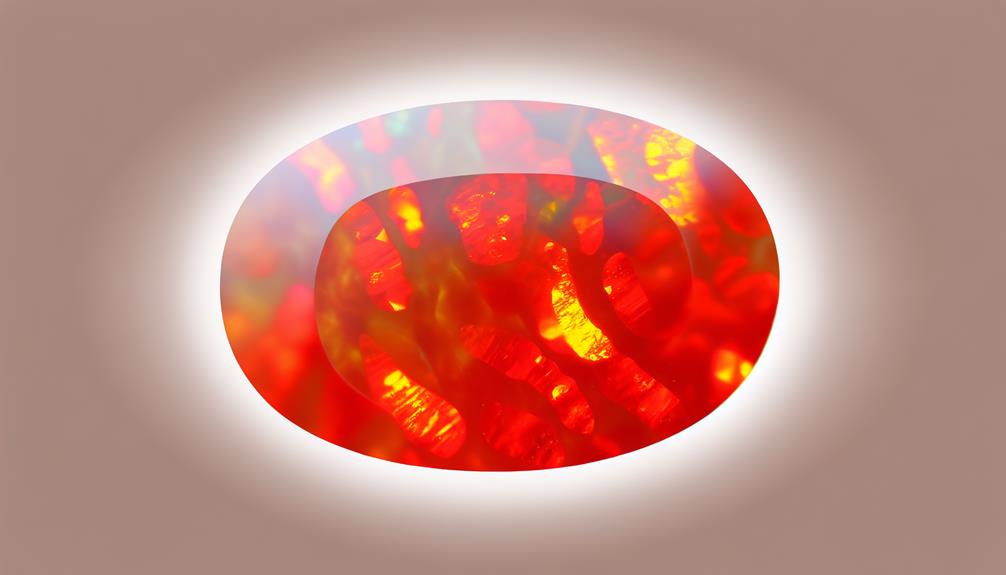
Common fire opal, characterized by its vibrant, warm hues ranging from yellow to deep red, lacks the play-of-color seen in precious opals but compensates with its striking body color and remarkable clarity. You'll find that this type of opal is highly valued for its transparency and intense coloration, making it ideal for various jewelry applications.
When evaluating common fire opal, consider the following key attributes:
- Color Saturation: The intensity of the hue directly affects the gemstone's value.
- Clarity: High clarity is prized, with fewer inclusions leading to higher quality.
- Cut: Precision in cutting enhances the stone's brilliance and overall appeal.
Conclusion
To sum up, comprehending the various kinds of fire opal—Mexican, Jelly, Cantera, Hydrophane, Ethiopian, Girasol, Cherry, Rainbow, and Common—demands precision, detailed analysis, and technical terminology.
Each variation presents exclusive optical characteristics, distinct color patterns, and specific geological structures.
By acknowledging these distinctions, you'll gain a deeper appreciation for the intricate beauty and worth that each variety of fire opal contributes to the field of gemology.
So, whether you're a collector, jeweler, or enthusiast, knowledge remains your most valuable asset.


